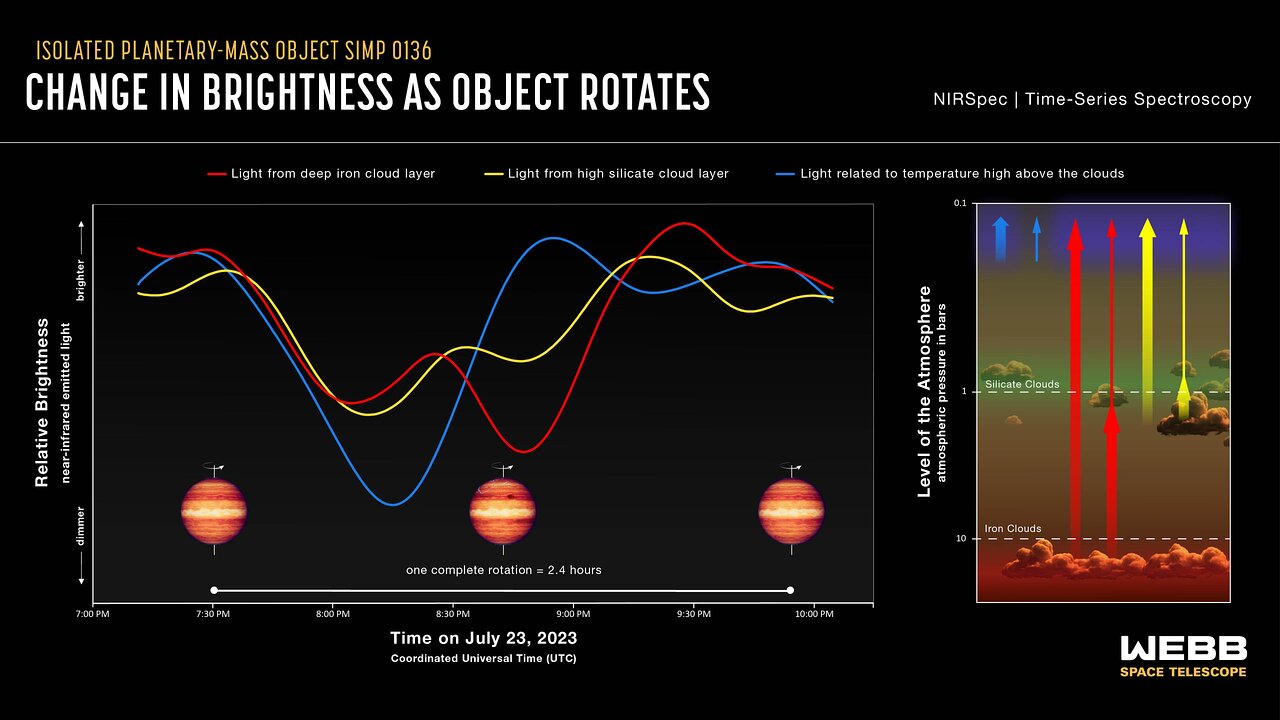Using the James Webb Space Telescope (JWST), researchers have generated the first-ever weather report of a rogue exoplanet-like object — and it shows patches of clouds and carbon chemicals, along with high-altitude auroras.
The findings, published March 3 in The Astrophysical Journal Letters, also revealed that the celestial object possesses a complex, layered atmosphere.
Earth’s atmosphere is a blanket of gases, primarily nitrogen and oxygen. But other planets in the solar system have very different atmospheres. For example, Venus’ air is much thicker than Earth’s and is vitriolic: it’s made of sulfuric acid. This diversity of atmospheres has also been observed in planets beyond our cosmic neighborhood: Some exoplanets have water vapor-soaked atmospheres, while others host superheated clouds of sand.
Now, researchers have pointed JWST at a mysterious object called SIMP 0136+0933 to learn more about its atmosphere. This object’s identity is still nebulous, said study lead author Allison McCarthy, a graduate student in Boston University’s astronomy department.
“[I]t’s not a planet in the traditional sense — since it doesn’t orbit a star,” she told Live Science in an email. However, “it also has a lower mass than a typical brown dwarf [a so-called ‘failed star‘],” she added.
Related: 32 alien planets that really exist
SIMP 0136+0933 has a 2.4-hour-long day and is located in the Carina Nebula 20 light-years away. Because it is the brightest free-floating planetary-mass object in the Northern Hemisphere and is far from stars that could obfuscate observations, it has been directly photographed by telescopes like NASA’s Spitzer Space Telescope. These observations revealed that SIMP 0136+0933 has an unusually variable atmosphere, with fluctuations in the electromagnetic spectrum’s infrared region (which humans would perceive as heat). But the physical phenomena causing this variability were still unknown.
To unravel these processes, McCarthy and colleagues used JWST’s Near-Infrared Spectrograph to measure the intensity of the short-wave radiation SIMP 0136+0933 emitted. They collected about 6,000 such datasets over nearly three hours on July 23, 2023, sampling data from the whole object. Then, over the next three hours, they repeated the process for longer wavelengths, using the space telescope’s Mid-Infrared Instrument.
The researchers then created light curves to show how the infrared radiation’s “brightness” (or intensity) changed over time. These curves revealed that different wavelengths behaved differently. At any one point, some brightened, others dimmed and others didn’t change. Despite this, the researchers found the light curves formed three clusters, each with a specific — albeit somewhat variable — shape.

The similar light-curve shapes suggested that similar atmospheric mechanisms were causing them. To determine these, the researchers built models of SIMP 0136+0933’s atmosphere. This enabled them to infer that the first wavelength cluster originated from a low-lying layer of iron clouds, with the second cluster coming from higher-lying clouds of forsterite, a magnesium mineral. The cloud layers were also probably patchy, which could have caused some of the variability in the wavelength clusters’ curves.
But clouds couldn’t explain the third wavelength cluster, which seemed to originate high above them. Instead, the researchers believe this radiation came from “hotspots,” or hot pockets of the atmosphere that may originate from radio auroras. These radio auroras resemble Earth’s northern lights, but they’re in the radio-wavelength range.
Yet even these models couldn’t explain all of the observations, like why the first cluster’s curves had such diverse shapes. The researchers proposed that clumps of carbon-based chemicals, such as carbon monoxide, in the atmosphere may have been responsible, absorbing radiation at some wavelengths at certain times.
“While these variability mechanisms had been hypothesized, this was the first time we observed them directly in SIMP 0136’s atmosphere,” McCarthy said. But a few hours of observations aren’t enough to understand SIMP 0136+0933’s atmosphere in the long term. For that, the researchers will need to study the object over several days, possibly with NASA’s Nancy Grace Roman Space Telescope, which is expected to launch in 2027.
